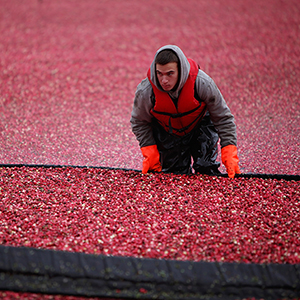- 4 Québec products to add to your recipes
- 10 Ways to Eat More Fruit Every Day
- Brighten up Your Plate with Citrus Fruit
- 12 Fresh Five-Star Salads
- Discover Hot and Sweet Peppers
- Eat More Nuts
- Enjoy Locally Grown Vegetables Year-Round
- Ways to Use Garden Vegetables
- Ketchups, Relishes, Chutneys, Marinades and Aromatic Vinegars
- Cranberries
- Cook with potatoes
- 8 Easy Recipes to Prepare Pumpkin—Differently
- Eat your veggies from the leaves to the roots
- Rediscover Fries!
- Super Salads!
- Eat more chickpeas
- Fruits and vegetables on the barbecue
- Apples on the menu
Cranberries
All About Cranberries

Cranberries are small juicy red or white fruits that are more than a little acidic and contain many tiny edible seeds.
The cranberry is in the same family as the blueberry and bilberry, and is originally from North America and Europe. The Amerindian name for cranberry is atoca.
The cranberry grows on shrubs found in humid and sandy soil. The berries are very sensitive to cold and are normally harvested in autumn. The harvest starts by flooding the fields, then picking the fruits that float up to the surface. The cranberry is massively cultivated in the United States, particularly in Massachusetts, but it is also an important crop in certain regions of Quebec.
In North America, the cranberry acquired its nobility as part of the traditional meal of roasted turkey served at Christmas and Thanksgiving.
Availability
Cranberries are most plentiful from October to December in your Metro supermarket.

Culinary Tips and Advice
- Choose fleshy, firm and shiny cranberries.
- Cook cranberries in a small amount of water in an open casserole because, just like popcorn, the cranberries will puff up and burst under the effect of the steam.
- They can be used to make pies, sherbets, mousses or crepes. Stewed cranberries, jellies or marmalades can be used in desserts.
- Given a chance, they also shine paired with poultry, pork, ham or fish.
- They add colour and tartness to sauces, jams, muffins, cakes, etc.
Expert Tip
Only wash cranberries prior to use. Beforehand, remove the stems and discard any fruits that are soft, wrinkled or damaged.
Storage Life
Cranberries deteriorate quickly if left at room temperature and should be refrigerated as soon as possible. They can be frozen as is, without adding sugar.
It is also possible to dehydrate them by drying them in an open lukewarm oven. To re-hydrate the cranberries, simply soak them for a few hours in water, juice or alcohol.
Nutritional Value
Cranberries are rich in Vitamin C, potassium and several acids including citric acid, which contributes to the distinctively tart taste. They are also high in antioxidants and a source of iron and Vitamin A. They promote good blood circulation, healthy skin and are beneficial to the digestive system. Regular consumption of fresh cranberries can help reduce the risk of cardiovascular diseases. Cranberry juice is also known to reduce the risk of urinary tract infections in women.
TRUE OR FALSE?
You have to add sugar to fresh cranberries before freezing them.
False. You can freeze cranberries without adding sugar. Stored in a plastic freezer bag, they will keep about one year and can be used frozen in recipes.
Cranberry juice is good for muscle pain.
False. Cranberries are helpful however in treating and preventing urinary tract infections
You can find dried cranberries on the market.
True. The market for cranberries has expanded since producers first started drying them. Like raisins, dried cranberries make a delicious snack, can be mixed with other dried fruit and nuts, or used in various bread, cake, muffin and cookie recipes.
Cranberries are harvested in late September and early October.
True. Cranberries are harvested in an unusual way. The bogs are flooded and water reels free the cranberries from the vines causing them to float on top of the water where they are corralled and removed by pumps or conveyors.

















